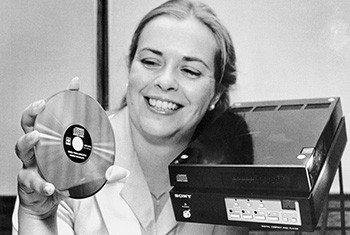Since CTA’s start in 1924 as the Radio Manufacturers Association, U.S. technology companies have had an advocate on Capitol Hill and across the country for innovation and free enterprise. As the competitive and regulatory climate has changed, so has our association. Find out in this five-part series how CTA has led industry growth and supported technology innovations that are solving big global challenges. This article, the series third, recaps the CTA story from 1980 to 1994.
The 1980s through the mid-1990s, widely characterized as an age of consumerism, was also a time of considerable tech innovation. Cable television took off, along with new devices for accessing and experiencing glamorous new worlds. Diana, Princess of Wales, was a fashion trendsetter frequently seen on global screens during an era when women were increasingly influencing labor markets by their numbers and presence in executive ranks.
Diverse populations were celebrated across cable and network channels on shows that depicted people of color in positions of authority, celebrity and respect. America’s buying power was also diversifying, as was the means through TV and devices to explore new and exciting lifestyles. Viewers wanted to buy what their idols bought, and wear what they wore. Consumers also wanted to go where the stars went, if only through broadcast programming and cassette recordings.
Technological innovations contributed in extraordinary ways to keep the music, sports, fashions and fresh voices going in people’s minds, hearts, homes and offices. CTA backstopped many of these innovations, largely through the halls of Congress. The organization helped legalize video recording at home. Also, CTA successfully championed the closed-captioning standard that, since the 1990s, has helped the hearing impaired join in the cultural and political events of the time.
1984: Historic Win in Sony-Betamax Supreme Court Case
EIA (now CTA) and Chairman of the Home Recording Rights Coalition (HRRC) Gary Shapiro advocated on behalf of VCR manufacturers. Shapiro, CTA’s current president and CEO, fought to uphold the legality of home videotaping. The Supreme Court’s ruling in favor of Sony and other VCR manufacturers paved the way for TV recording.

Member company Sony debuted the new Compact Digital Audio Disc and the Digital Compact Disc Player at CES 1981. Compact disc (CD) players went on sale for the first time in the U.S. in 1982. Source: Getty Images.
1984-1986: Shaping Stereo, and the TV Experience
In 1984, the Federal Communications Commission (FCC) approved multichannel TV sound (MTS) which provided the extra dimension of stereo for more powerful audio. As reviewers commented then, the technology brought the sounds to life. Footsteps, for example, and door slams seemed to be in the same room. Gunfire on popular crime procedurals like Miami Vice sounded almost too close for comfort. In 1986, the Consumer Electronics Group (CEG, a division of CTA predecessor EIA) was honored with an Emmy for its industry-shaping role in advancing stereo television.
1988: Standards For Total Home Automation
CEG was instrumental in contributing standards that helped pave the way to the automated home. The Consumer Electronics (CE) Bus group developed the standard that encompassed a unified hand-control system that established a common communication network through which any consumer electronics devices could interact, and exchange control information and data.
1990: Closed Captioning Is Signed into Law
Legislation was passed requiring closed-captioning decoders in all larger color TVs manufactured after July 1, 1993. Over the next three years, the Federal Communications Commission (FCC) adopted the EIA closed-captioning standard. Today, this standard is known as CEA-608.
Key takeaway from nine pivotal years when consumer tech took off: Industry breakthroughs united communities, bridging divides in society, the labor force and politics. CTA’s leaders, recognizing consumer tech’s potential, fought vigorously for laws and regulations that allow industry to continue innovating for a more inclusive society. Find out how consumer-focused technology continued to advance access through the Internet, cell phones, GPS and more in the fourth article of this series, Igniting Innovation Since 1924: Digital Transformation. What developments were shaking the industry before 1980? Find out in the first, second and third articles of this series for a look at CTA’s Radio Era, Television Era and Digital Transformation advocacy.